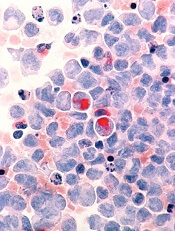
Credit: Lance Liotta
A small gene embedded in a larger gene appears to be the driving force behind acute myeloid leukemia (AML) development, according to research published in Science Signaling.
The smaller gene, microRNA-3151 (miR-3151), is embedded in intron 1 of the larger gene, BAALC.
As both genes have been associated with poor prognosis in AML, researchers wanted to determine the degree to which each of the genes contributes to AML.
“We discovered that the smaller microRNA gene, and not the larger host gene, is the major oncogenic driver of the 2 molecules in AML,” said principal investigator Albert de la Chapelle, MD, PhD, of The Ohio State University Comprehensive Cancer Center (OSUCCC) in Columbus.
“When both genes are highly expressed, it means a bad prognosis for patients, but our experiments indicate that it is high expression of miR-3151 that really matters. Overexpression of BAALC alone had only limited cancer-causing activity.”
Dr de la Chapelle and his colleagues used AML cells derived from patients, AML cell lines, and an animal model of the disease to investigate the role of miR-3151 and BAALC in older patients with cytogenetically normal AML.
The team found that miR-3151 promotes leukemia development by targeting the tumor suppressor TP53 and 7 other genes in the TP53 pathway.
“When miR-3151 blocks TP53 in the tumor cells, it enables the cells to survive, divide, and grow faster,” said study author Clara D. Bloomfield, MD, of OSUCCC.
Experiments also showed that overexpressing miR-3151 promotes AML cell growth. BAALC overexpression enhances that effect, but blocking miR-3151 or overexpressing TP53 reverses it.
In mice, miR-3151 alone and in combination with BAALC promoted leukemia development.
Finally, the researchers discovered that miR-3151 overexpression can be inhibited by the proteasome inhibitor bortezomib, which suggests a possible therapy for miR-3151 overexpression.
“About one-third of the several hundred known human microRNAs are encoded in host genes,” said study author Ann-Kathrin Eisfeld, MD, of OSUCCC.
“We know very little about how microRNAs located within introns are regulated and how they interact with their host genes. These findings provide an important example of that interaction.”

